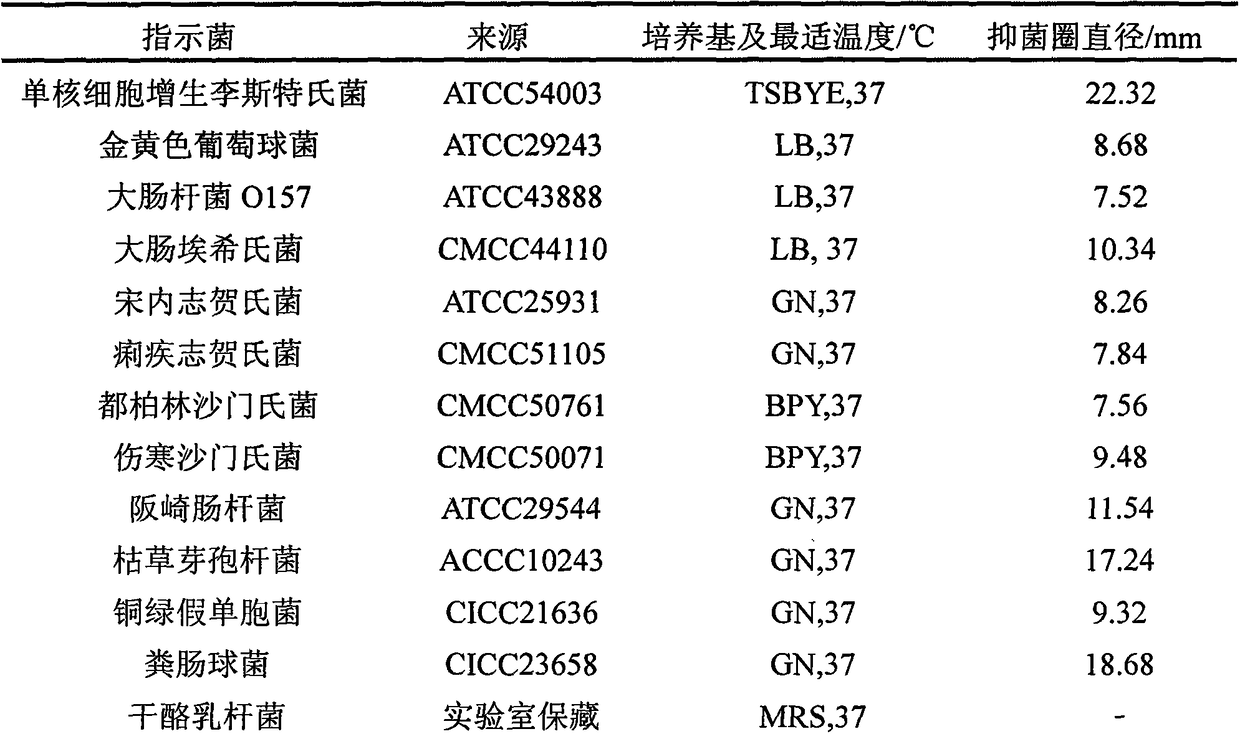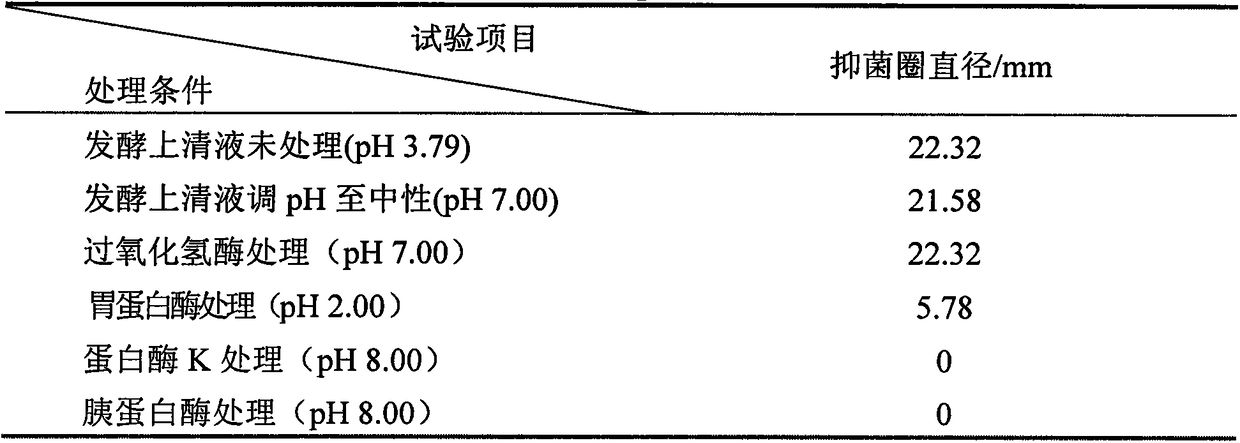A kind of Lactobacillus plantarum plant subspecies and its anti-Listeria monocytogenes bacteriocin preparation method
A technology of Lactobacillus plantarum and bacteriocin, which is applied in the field of microorganisms, can solve the problems that there are no literature and reports on the preparation method of Lactobacillus plantarum subspecies bacteriocin, and achieve the effects of low cost, improved purity, and reliable and safe sources
- Summary
- Abstract
- Description
- Claims
- Application Information
AI Technical Summary
Problems solved by technology
Method used
Image
Examples
Embodiment 1
[0029] Embodiment 1, screening and identification of lactic acid bacteria strain Zhang-LL with bacteriostatic activity
[0030] 1. Screening of lactic acid bacteria strain Zhang-LL with antibacterial activity
[0031] Take 1 g of the ground bacon product and put it into 9 mL of sterile saline, shake it fully for 20 minutes to make a suspension, and dilute it 10 times to 10 -4 ~10 -7 Smear each dilution sample suspension on the MRS selective medium containing 0.4% bromocresol purple, culture at 37°C for 24 hours, pick yellow colonies for Gram staining, and transfer to MRS In the liquid medium, the bacteria were enriched for 2 to 3 generations at 37°C, and the fermentation supernatant was collected by centrifugation, and the Oxford cup method was used to judge whether the strain had antibacterial activity by observing the size of the inhibition zone.
[0032] The determination of antibacterial activity adopts the Oxford cup method: first dilute the indicator bacterial strain t...
Embodiment 2
[0057] Embodiment 2, the extraction of Lactobacillus plantarum subspecies Zhang-LL bacteriocin
[0058] 1. The fermentation process conditions of bacteriocin
[0059] The medium components (w / v) for cultivating Lactobacillus plantarum subspecies Zhang-LL producing bacteriocin: tryptone 1%, beef extract 1%, yeast extract powder 0.5%, triammonium citrate 0.2%, glucose %, Tween-800.1%, sodium acetate 0.5%, dipotassium hydrogen phosphate 0.2%, magnesium sulfate 0.05%, manganese sulfate 0.025%, pH 6.5-7.0, sterilized at 121°C for 20min.
[0060] Fermentation process conditions for producing bacteriocin: fermentation temperature 37° C., fermentation time 20 h, initial pH of the medium 6.5, inoculum size 1%.
[0061] 2. Extraction of bacteriocin in fermentation broth
[0062] (1) Adsorption of bacteriocins to producing bacterial cells The adsorption characteristics of bacteriocins to producing bacterial cells were measured by test. The lactic acid bacteria fermentation broth obtain...
Embodiment 3
[0072] Embodiment 3, Lactobacillus plantarum subspecies Zhang-LL bacteriocin purification method
[0073] 1. Purification method of Lactobacillus plantarum subspecies Zhang-LL bacteriocin
[0074] (1) Preliminary purification of bacteriocin by cation exchange chromatography. The crude bacteriocin extracted sample was redissolved in sterile distilled water, filtered through a 0.22 μm sterile filter membrane, and then purified by SP Sepharose Fast Flow cation exchange chromatography. Analysis column size is 10mm×100mm; loading buffer: 20mmol / L pH3.4 citric acid-sodium citrate buffer; eluent: 0.8mol / L NaCl citric acid-sodium citrate buffer; elution conditions : Isocratic elution with 20% eluent for 20 minutes, linear gradient elution with 20% to 100% eluent for 100 minutes; flow rate: 1mL / min, sample volume: 1mL, automatic collector 5mL / tube, and absorbance at 280nm There is an eluate with an absorption peak and antibacterial activity; put the collected solution with antibacterial...
PUM
 Login to View More
Login to View More Abstract
Description
Claims
Application Information
 Login to View More
Login to View More - Generate Ideas
- Intellectual Property
- Life Sciences
- Materials
- Tech Scout
- Unparalleled Data Quality
- Higher Quality Content
- 60% Fewer Hallucinations
Browse by: Latest US Patents, China's latest patents, Technical Efficacy Thesaurus, Application Domain, Technology Topic, Popular Technical Reports.
© 2025 PatSnap. All rights reserved.Legal|Privacy policy|Modern Slavery Act Transparency Statement|Sitemap|About US| Contact US: help@patsnap.com



